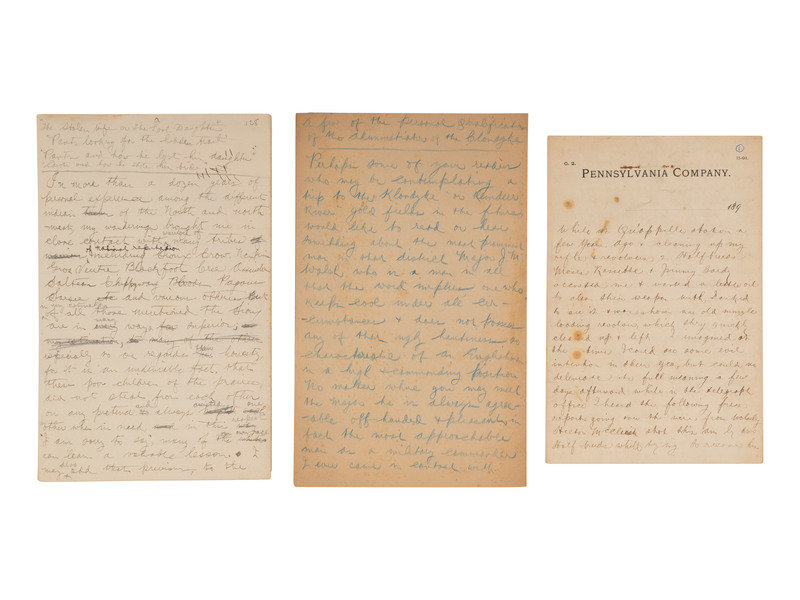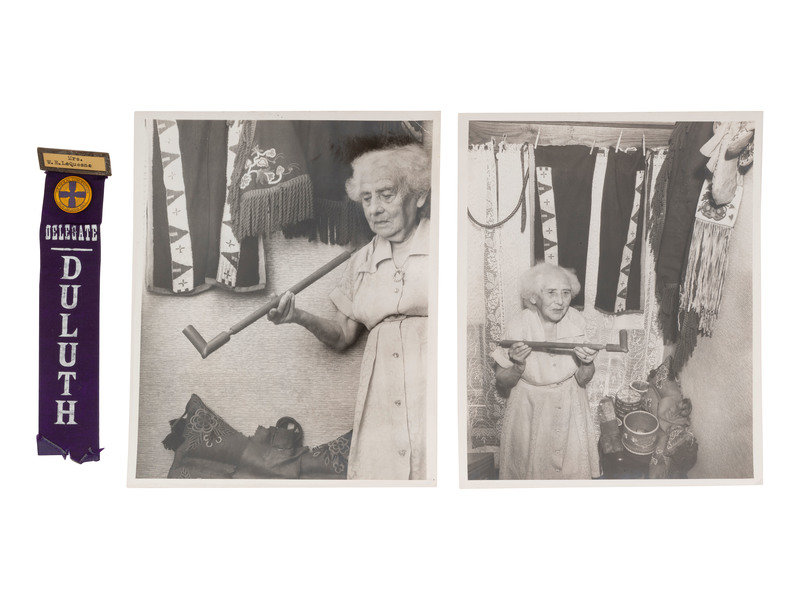Condition Report
Contact Information
Auction Specialist
Lot 202
[WESTERN AMERICANA]. Archive of US Army Indian Scout and interpreter, William E. Archbold LeQuesne (1858-1915), featuring retrospective accounts of Sitting Bull and the Plains Indians Wars.
Sale 1192 - American Historical Ephemera & Photography
Lots 1-294
Jun 15, 2023
10:00AM ET
Lots 295-567
Jun 16, 2023
10:00AM ET
Live / Cincinnati
Own a similar item?
Estimate
$2,000 -
3,000
Price Realized
$2,016
Sold prices are inclusive of Buyer’s Premium
Lot Description
[WESTERN AMERICANA]. Archive of US Army Indian Scout and interpreter, William E. Archbold LeQuesne (1858-1915), featuring retrospective accounts of Sitting Bull and the Plains Indians Wars.
3 letters; 7 manuscript memoirs; "Delegate / Duluth" ribbon identified to Mrs. W.E. LeQuesne; newsclippings; misc. documents, and 3 photographs. Items generally in good condition with expected wear, toning, and soil given age. Paper is not of uniform quality and some pages with loss and chipping at the edges, affecting relatively little text.
Memoirs, comprising: 17pp essay signed "Matoptecela," July 31, 1900, relating an incident in which LeQuesne took part, stealing a wife in Sitting Bull’s camp for a young man (Coyote) who had too few horses to trade for a wife: "Now as stealing a squaw was a crime in a Sioux camp and the girl’s father (Pants) had the privilege of shooting the thief, if he caught him inside of three says, it was a serious matter." An exciting chase follows, Lequesne managing to evade all repercussions for his part in the theft, and account of Coyote’s return after the statute of limitation ran out, ingratiating himself to the father and camp. -- A second version of the Coyote-Pants story, a bit longer, but perhaps incomplete. -- "A few of the personal qualifications of the administration of the Clondyke," 7pp (incomplete). Includes a fascinating discussion of Gen. Nelson Miles inviting Long Dog and other "hostile" Indians and Custer-veterans to see the operation of the Gattling Gun, with LeQuesne acting as interpreter: "The exclamation of this warrior on seeing a little butte or hill torn up by one discharge of the gun made our hair stand on end and I would not like to see it on paper. The General checked the Indian for using such language, and asked him where he learned to swear in that way, and cautioned him not to do so again. The Indian replied that he had learned it all from the soldiers and if he did not like to hear the Indians talk that way, he should forbid the soldiers using such words in their hearing..." -- "While on the Qu’appelle station," 8pp, regarding two ill-inclined men of mixed-race descent who committed murder and were pursued until captured by the Mounted Police. -- "Life in a Sioux camp a few years after the Black Hills trouble," 2pp (incomplete). Describing a visit to Sitting Bull’s camp. -- "For the Boys and Girls Weekly," a memoir apparently aimed at a younger audience, but with excellent content, 15pp. "As bloodthirsty & cruel as the Sioux warrior was known to be he no doubt had a bump of hospitality which I will undertake to prove from a little personal experience. During the winter of ’79 buffalo were plentiful on some of our western plains & Sitting Bull with about 400 lodges of his followers were encamped on the White Mud River hunting. I was one of a party going over the prairie in question & got lost in a snow storm before reaching the crossing the White Mud..." --
Memoir of Indian service, 8pp. Includes an account of Sitting Bull’s surrender to American forces, handing his gun to a young boy and saying "here my boy hand my gun & give my horse to the White Chief. You will never be a man for you cannot have a gun to shoot your enemies with." Also account of Indian hunting accidents, the survivor of an attack by the Blackfoot and the revenge exacted; and an account of interpreting for the Canadian government during the rebellion of 1885, including the capture of Star Blanket.
[With:] 3 letters, including: A letter of recommendation from R. Brinton Deane, March 22, 1894, attesting that LeQuesne "served as Sioux interpreter and Scout under my command during the rebellion of 1885" rendering "valuable service," and crediting him with the capture of "Chief Star Blanket and White Cap, two troublesome Indians of whose whereabouts it was very difficult to obtain reliable information." A TLS from Gen. Nelson A. MILES, recalling LeQuesne’s service in the Yellowstone (Aug. 4, 1904). -- A typed diary (in photocopy only) of "Aunt Beth’s [Archbold’s wife]... 500 miles drive through the South Dakota Plains to attend a Sioux Indian church Convocation," 8pp, 1902;. -- A printed discharge from the North West Mounted Police Force, June 9, 1884; a Knights of Pythias membership; newsclippings; and 3 photos, two of Mrs. LeQuesne with peace pipe (ca 1956), and a printing-out paper print of a white man, most likely LeQuesne, and Long Dog, a "Head Warrior" (Camp Policeman) in Sitting Bull's camp during the Canadian exile. This may be from an otherwise unknown photo by David F. Barry, ca. 1887-88, taken at Standing Rock Reservation, D.T.
[Also with:] Five articles written for newspapers, ca.1893, each on folio sheets. Content includes memoirs of arresting Indians for attempted murder; Indian horses; and spending a New Year with one of the leaders of the Minnesota Massacre in 1887. -- Purple and yellow "Delegate / Duluth" ribbon identified to Mrs. W.E. LeQuesne.
As a young man, William E.A. LeQuesne joined the Royal Canadian Mounted Police. He served in the Canadian west, doing active duty during the Northwest Rebellion of 1885 (an unsuccessful attempt by the Metis and Indian allies to break free of Anglo-Canadian domination), and during the cross-border tensions with the United States during the Plains Indian Wars. LeQuesne served as an interpreter and scout for the Americans under Gen. Nelson A. Miles as well as for the Canadians. Fluent in the Dakota language and apparently conversant in other languages from the Upper Plains, LeQuesne was not a simple caricature of an "Indian fighter," he lived among the tribes on a friendly basis and claimed to have befriended Sitting Bull himself, even claiming that Sitting Bull offered his daughter to him in marriage -- an offer LeQuesne delicately declined, referencing his wife in the east.
Later in life, LeQuesne and his wife taught at an Indian mission school in the Dakotas. There he achieved some minor fame as a lecturer and writer, sometimes using the Dakota moniker "Matoptecela," and drawing upon his experiences during the 1870s and 1880s to produce very readable narratives about life among the “Sioux.” His narratives are styled to some extent in the classic western genre, exciting and detailed, but also carry an authenticity lacking in many accounts of life among the Indians due in no small way to his personal experience. LeQuesne, by his own account, had known warriors not only from the Sioux and Blackfoot, but also Crow, Nez Perce, Gros Ventres, Cree, Assiniboine, Salteau, Chippewa, Blood, Piegan, and Sarcee.
A superb record of a Canadian veteran of the Plains Indian Wars of the 1870s and 1880s.
Property from the Patrick Atkinson Collection, Minneapolis, Minnesota
This lot is located in Cincinnati.













